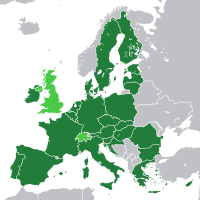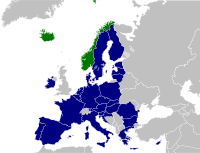Apportionment in the European Parliament
[1] Thus the allocation of seats is not strictly proportional to the size of a state's population, nor does it reflect any other automatically triggered or fixed mathematical formula.
After the withdrawal of the United Kingdom from the EU in 2020, the number of MEPs, including the president, dropped to 705[2] but since the 2024 election, it increased to 720.
When the Parliament was established in 1952 as the 78-member "Common Assembly of the European Coal and Steel Community" the then-three smaller states (Belgium, Luxembourg, and the Netherlands) were concerned about being under-represented and hence they were granted more seats than their population would have allowed.
[4] It then grew further with each enlargement, which each time allowing smaller nations to have greater proportion of seats relative to larger states.
The 2009 European Parliament election was conducted under the rules included in the Nice Treaty which provided for a maximum number of 736, although that figure had been breached on the accession of new members to the EU, these states being allowed parliamentary representation without a corresponding reduction in the number of MEPs allotted to other member states.
[9] Italy would have been the greatest loser under the Lisbon system and sought the same number of MEPs as France and the United Kingdom.
After the 2009 election, Duff proposed a new version of his report,[17] which was adopted by the parliamentary Committee on Constitutional Affairs (AFCO) in April 2011.
A third version of the report[18] was published in September 2011 and adopted by the AFCO committee in January 2012, but was withdrawn before being discussed in plenary in March 2012 for fear that it would likely be turned down.
The same document suggests the creation of a formal process "based on objective criteria to be applied in a pragmatic manner" for apportioning seats in future elections.
One plan, supported by Enrico Letta, Gianni Pittella and Emmanuel Macron, was to replace the 73 seats with a pan-European constituency list.
The draft report suggested a new apportionnement which aimed at respecting the degressive proportionality while also resulting in no loss of seats for any Member State, therefore leading to an expansion in the number of MEPs, from 705 to 716.
[3] Furthermore, this decision envisages the future (before the 2029-2034 parliamentary term) definition of "an objective, fair, durable and transparent seat distribution method implementing the principle of degressive proportionality, without prejudice to the institutions’ prerogatives under the Treaties".





